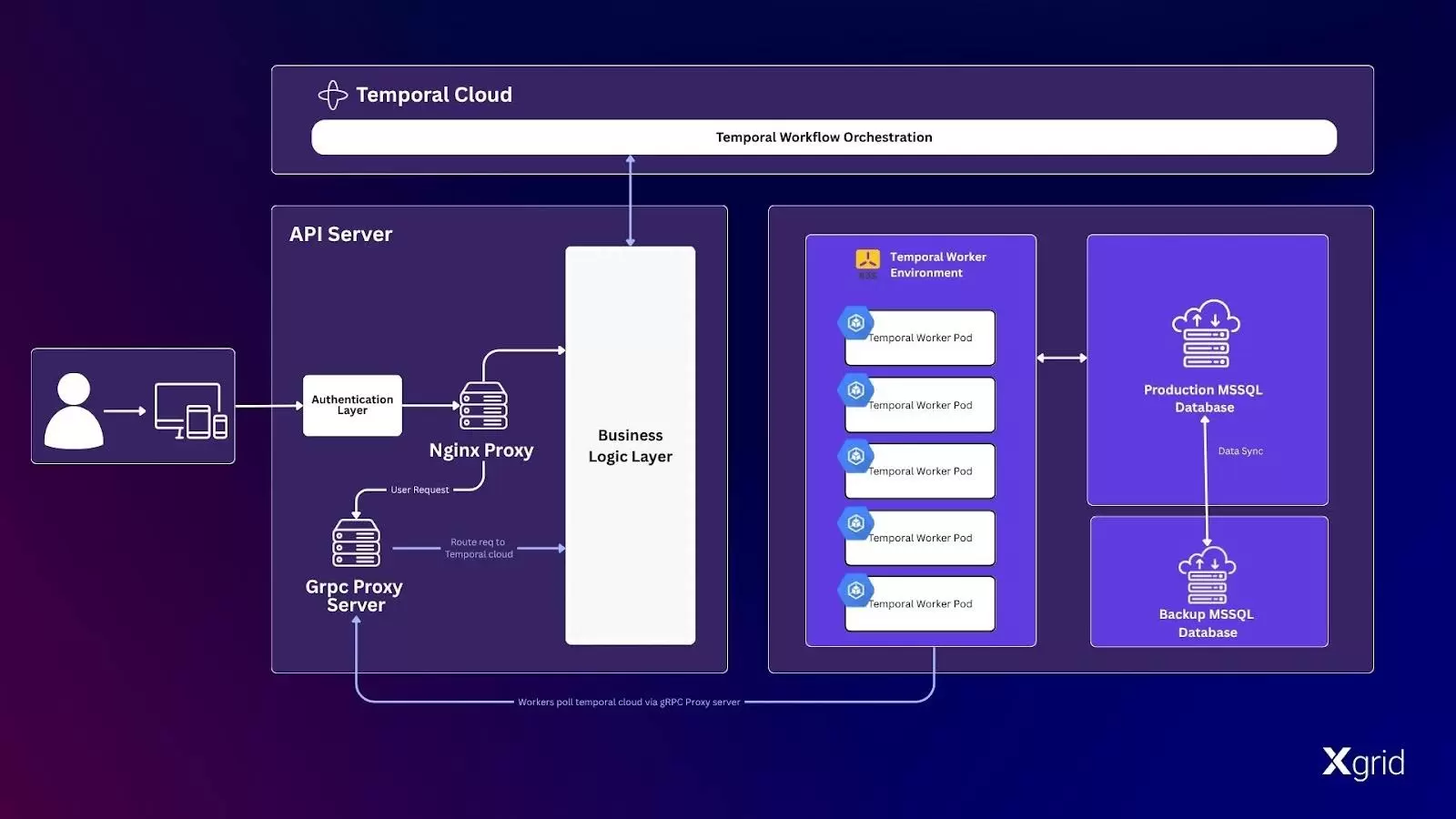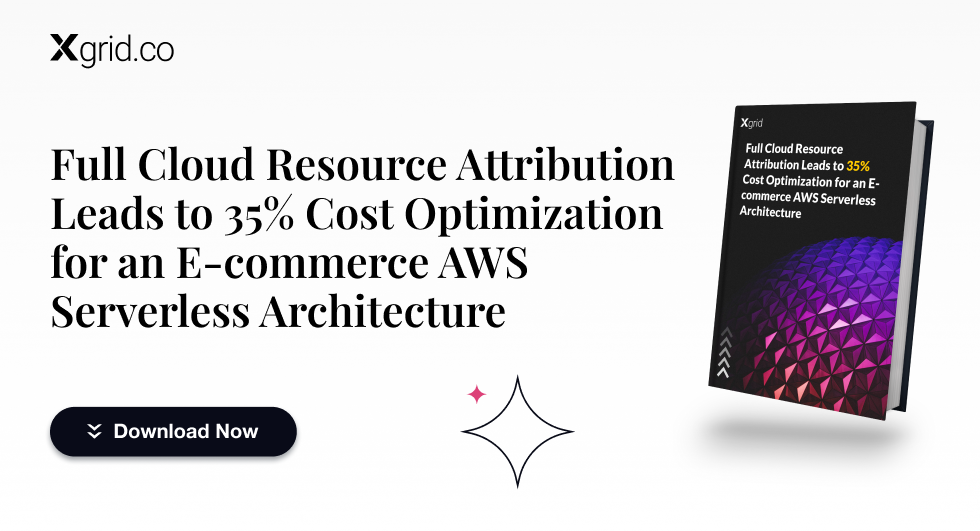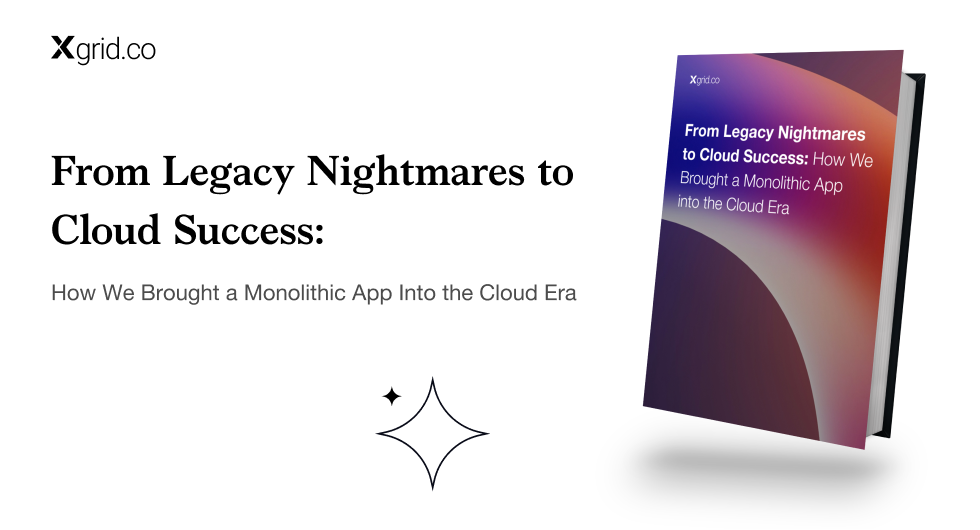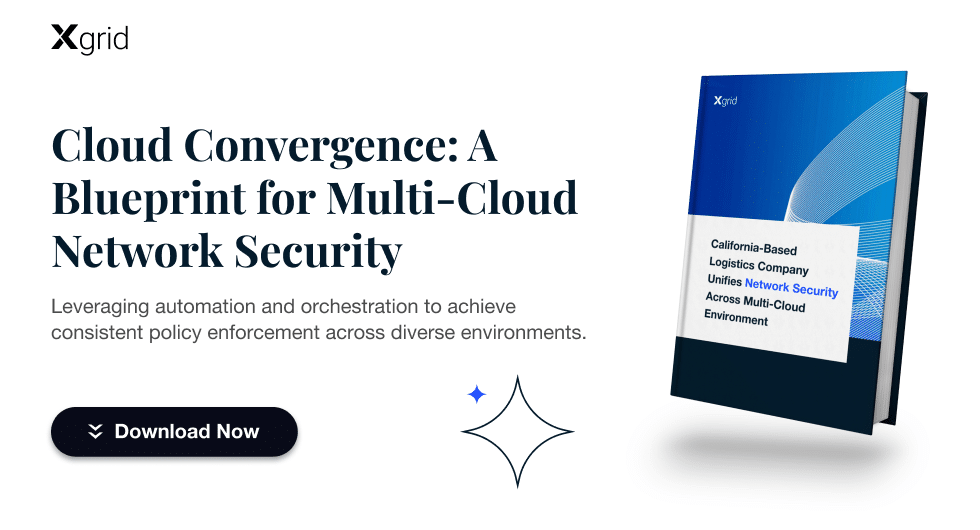How Modernizing Legacy Infrastructure Unlocks ‘Five Nines’ Reliability with Temporal
Executive Summary
A major enterprise client approached us with plans to modernize their legacy on-premises infrastructure and address some operational challenges they’d been experiencing. Their existing workflow systems, while functional, were showing signs of strain under increasing load and complexity. Through strategic implementation of Temporal’s workflow orchestration platform, we helped them transform their infrastructure into a robust, enterprise-grade solution that now maintains 99.999% uptime across mission-critical operations.
The Opportunity: Modernizing Legacy Infrastructure
Our client serves thousands of users daily and had been successfully operating on legacy on-premises infrastructure for years. However, as their business grew, they began experiencing challenges that indicated it was time for an upgrade.
Modernization Goals
The client came to us with clear objectives for their infrastructure modernization:
- Address intermittent workflow reliability issues that were becoming more frequent
- Improve system observability and monitoring capabilities
- Enhance error handling and recovery mechanisms
- Reduce manual intervention requirements for system maintenance
- Prepare their infrastructure for future scale and complexity
Their legacy systems, while stable, lacked the sophisticated error handling, retry mechanisms, and observability features that modern enterprise workflows demand.
Discovery: Understanding the Current State
Before proposing solutions, we conducted a comprehensive assessment of their existing infrastructure and application architecture. This discovery phase helped us understand both their current capabilities and areas for improvement.
Infrastructure Assessment
Our analysis revealed several areas where modernization would provide significant value:
Resource management could be optimized. The existing setup lacked proper resource isolation, which occasionally caused competing workflows to impact each other during peak usage periods.
Resilience patterns were limited. While the system was generally stable, there were opportunities to implement better redundancy and graceful degradation strategies.
Error handling was basic. The system had minimal retry logic and limited sophisticated error recovery mechanisms.
State management could be enhanced. Workflow state persistence was functional but could benefit from more robust approaches to handle edge cases.
Application Architecture Analysis
The application layer showed similar opportunities for improvement:
Services had some tight coupling that could be loosened to improve maintainability. Long-running processes occasionally created bottlenecks that could be addressed with better asynchronous patterns. Monitoring and alerting capabilities were adequate but could be significantly enhanced for proactive issue detection.
Solution Architecture: Why Temporal Was the Perfect Fit
After evaluating multiple workflow orchestration platforms, Temporal emerged as the ideal solution for this modernization initiative.
Temporal’s Core Advantages for Enterprise Workflows
Durable execution ensures workflows survive process crashes, server restarts, and network partitions without losing state or progress—a significant upgrade over their existing state management.
Built-in reliability features like automatic retries, exponential backoff, and dead letter queues are handled natively by the platform, eliminating the need for custom implementations.
Enterprise scalability allows handling thousands of concurrent workflows while maintaining consistent performance and reliability.
Rich observability provides comprehensive workflow visibility, including execution history, current state, and detailed logging.
Hybrid Cloud Strategy
Rather than requiring a complete cloud migration, we implemented a hybrid approach that respected their security requirements while leveraging cloud capabilities:
- Temporal Cloud for Orchestration: Utilizing Temporal Cloud’s managed service for the workflow engine, ensuring high availability and managed updates
- On-Premises Execution: Critical business logic and data processing remained on-premises, satisfying compliance and security requirements
- Custom Proxy Architecture: A secure proxy layer enabling seamless communication between cloud orchestration and on-premises execution
Implementation Deep Dive
Phase 1: Pilot Project Selection
We selected one of their most critical workflows for the pilot implementation—a process used by the majority of their user base daily. This workflow involved multiple steps including data validation, processing, third-party API calls, and database updates.
Phase 2: Workflow Redesign
The existing workflow was refactored into discrete, idempotent activities:
Original Workflow: User Request → [Single Comprehensive Process] → Result
New Temporal Workflow: User Request → Data Validation → Processing → API Calls → Database Updates → Notification → Result
Each step became a separate Temporal activity with proper error handling, timeouts, and retry policies.
Phase 3: Security Implementation
Security was paramount given the hybrid nature of the solution:
Central gRPC Server with End-to-End Encryption
We implemented a central gRPC server that acts as the single point of communication between Temporal Cloud and on-premises infrastructure. This architecture provides several critical security benefits:
Centralized Traffic Routing: All communication flows through the central gRPC server, providing a single point of control for security policies, monitoring, and access management.
End-to-End TLS Encryption: We implemented comprehensive E2E TLS 1.3 encryption across all communication channels. Every connection from Temporal Cloud to the central gRPC server, and from the server to on-premises workers, uses mutual TLS authentication with certificate pinning.
Protocol Security: The gRPC server handles secure protocol translation and maintains encrypted channels throughout the entire communication path, ensuring no data is transmitted in plaintext at any point.
AES-256 Encryption at Rest
All sensitive data is protected using AES-256 encryption at rest:
Workflow Data Encryption: Sensitive workflow data is encrypted using AES-256 before being stored in Temporal Cloud, with encryption keys managed through the client’s existing key management infrastructure.
Database Encryption: All on-premises databases use AES-256 encryption for data at rest, with encrypted backups and transaction logs.
Configuration Security: Application configurations, certificates, and other sensitive files are encrypted at rest using AES-256 with key rotation policies.
Secrets Management with AWS Secrets Manager
A critical component of our security architecture was implementing robust secrets management using AWS Secrets Manager:
Centralized Secret Storage: All sensitive configuration data, including database credentials, API keys, and AES-256 encryption keys, are stored securely in AWS Secrets Manager with automatic rotation capabilities.
Dynamic Secret Retrieval: The central gRPC server and on-premises workers dynamically retrieve secrets at runtime, eliminating the need to store sensitive data in configuration files or environment variables.
Audit Trail: All secret access is logged and auditable, providing complete visibility into when and how sensitive data is accessed.
Integration Security: The secrets management system integrates seamlessly with their existing AWS infrastructure while maintaining the security boundary between cloud orchestration and on-premises execution.
Additional Security Features
- Network Isolation: On-premises workers operate within isolated network segments with carefully controlled access rules
- Certificate Management: Automated certificate lifecycle management with regular rotation and validation
- Security Monitoring: Comprehensive logging and monitoring of all security events, including failed authentication attempts and unusual traffic patterns
Phase 4: Testing Strategy
We implemented comprehensive testing across multiple levels: Unit tests validate individual activity logic and error handling, while integration tests verify end-to-end workflow execution and failure scenarios. Load and performance testing ensure the system maintains reliability under peak conditions, with Temporal’s testing framework enabling simulation of various failure modes and recovery patterns.
Phase 5: Monitoring and Observability
We implemented comprehensive monitoring covering workflow execution metrics, infrastructure health, business KPIs, and proactive alerting for anomalies. The enhanced observability provides real-time visibility into workflow states and execution patterns, enabling proactive issue identification and resolution.
Results: Achieving Five-Nines Reliability
The modernization results exceeded expectations:
Reliability Improvements
- 99.999% SLA Achievement: The pilot workflow now maintains 99.999% uptime, representing less than 5 minutes of downtime per year
- Zero Data Loss: Temporal’s durable execution guarantees ensure no workflow executions are lost, even during system failures
- Automatic Recovery: Enhanced retry and recovery mechanisms handle most transient issues without manual intervention
Performance Gains
- Improved Throughput: The decomposed workflow architecture enables better parallelization and resource utilization
- Reduced Latency: Asynchronous processing and optimized resource management reduced average workflow completion times by 40%
- Better Resource Utilization: The hybrid approach optimizes resource usage between cloud orchestration and on-premises execution
Operational Excellence
- Proactive Monitoring: The team now identifies and addresses potential issues before they impact operations
- Simplified Debugging: Temporal’s workflow visibility makes identifying and resolving issues straightforward
- Reduced Manual Interventions: Automated systems handle most operational tasks that previously required manual attention
Technical Architecture Details
Temporal Cloud Integration
Our implementation leverages Temporal Cloud’s managed service while maintaining data sovereignty:
- Workflow Definitions: Stored and executed in Temporal Cloud for high availability and automatic scaling
- Activity Execution: Business logic runs on-premises through Temporal workers, ensuring sensitive operations remain within the client’s infrastructure
- State Management: Workflow state is managed by Temporal Cloud, with sensitive data encrypted and tokenized before storage
Data Security and Compliance
- Multi-layered Encryption: Application-level encryption for sensitive business data, TLS encryption for all network communication, and database-level encryption for persistent storage
- Compliance Alignment: The solution maintains compliance with industry regulations while leveraging cloud capabilities
- Comprehensive Audit Trail: Complete logging and audit trails for all workflow executions and data access
Lessons Learned and Best Practices
Implementation Insights
Starting with critical workflows ensures maximum business value and stakeholder engagement. The phased approach allowed for learning and adjustment without disrupting existing operations. Addressing security requirements upfront prevented costly architectural changes later in the process.
Operational Best Practices
Investing in comprehensive observability from day one provides significant operational benefits. Temporal workflows can be thoroughly tested, including failure scenarios and recovery paths. Ensuring team members understand both Temporal concepts and the specific implementation is crucial for long-term success.
Looking Forward: Scaling the Success
Based on the pilot project’s success, the client is now planning to migrate additional workflows to the Temporal-based architecture. The proven reliability and operational benefits make this a natural evolution of their modernization initiative.
Future Enhancements
- Multi-Region Deployment: Expanding the hybrid architecture to support multiple geographic regions for enhanced performance and disaster recovery
- Advanced Analytics: Leveraging workflow execution data for business intelligence and process optimization
- Integration Expansion: Connecting additional enterprise systems to the Temporal workflow ecosystem
Conclusion
The transformation from legacy infrastructure to a modern, highly reliable hybrid cloud solution demonstrates the value of strategic technology modernization. Temporal’s workflow orchestration capabilities, combined with thoughtful architecture and security design, enabled this enterprise client to achieve near-perfect reliability while maintaining their security and compliance requirements.
The 99.999% SLA achievement represents more than just improved uptime—it reflects enhanced operational confidence, better user experience, and the foundation for continued business growth and innovation.
For enterprises considering similar infrastructure modernization initiatives, this case study demonstrates that significant improvements in reliability and operational efficiency are achievable with the right approach. The key lies in thorough assessment, appropriate technology selection, and careful implementation that respects both technical requirements and business constraints.
This case study represents a collaboration between Xgrid’s engineering team and a major enterprise client. The solution architecture and implementation details have been reviewed and approved for publication while maintaining client confidentiality.
Facing workflow reliability challenges or looking to modernize your legacy infrastructure? Talk to Xgrid about how we can help transform your systems with proven enterprise-grade solutions.




